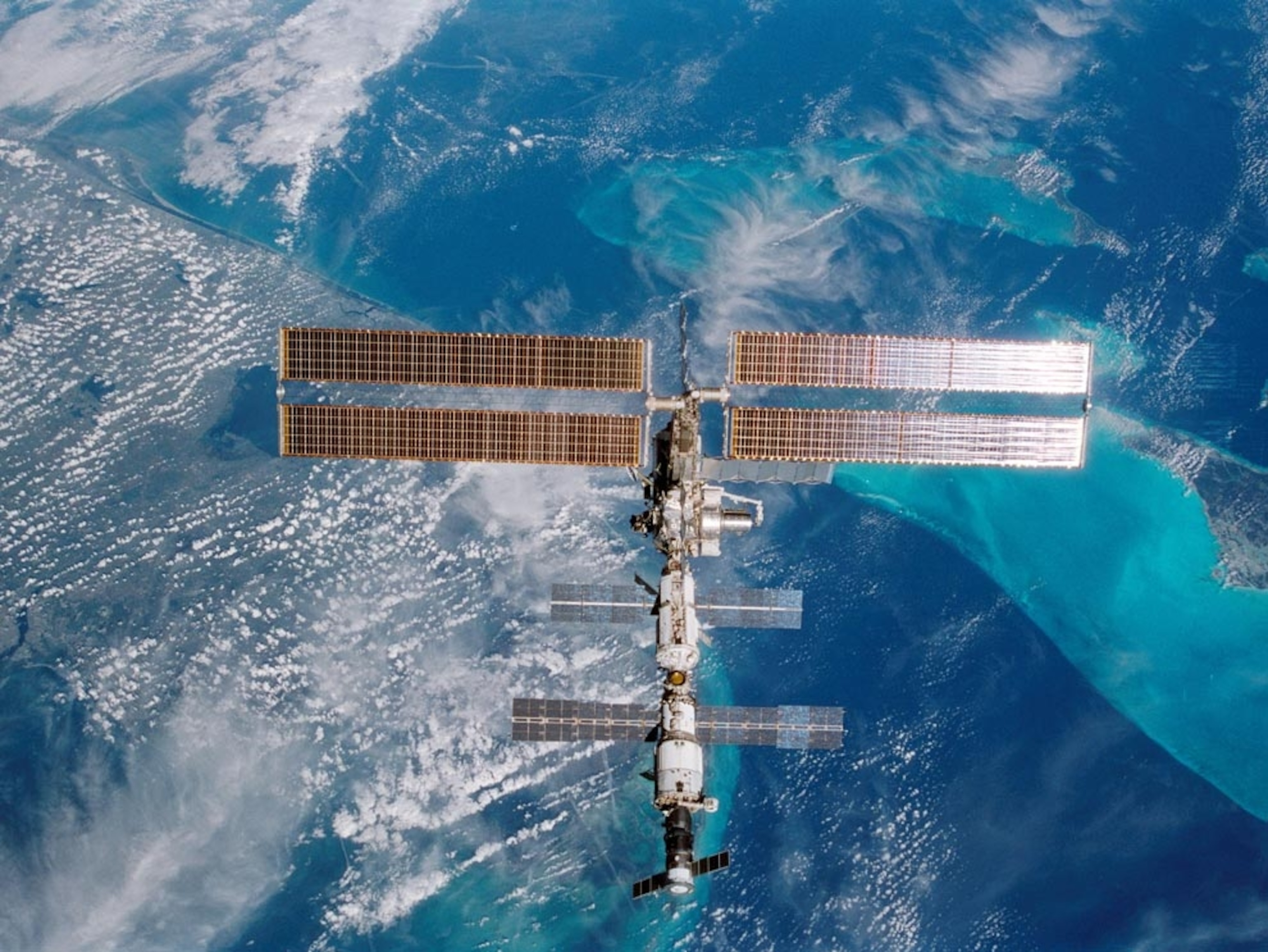The skies above Earth are teeming with more than 8,000 manmade objects, large and small. The U.S. Space Surveillance Network uses radar to track more than 13,000 such items that are larger than four inches (ten centimeters). This celestial clutter includes everything from the International Space Station (ISS) and the Hubble Space Telescope to defunct satellites, rocket stages, or nuts and bolts left behind by astronauts. And there are millions of smaller, harder-to-track objects such as flecks of paint and bits of plastic.
Satellites
For half a century, humans have been putting satellites into orbit around Earth to serve a variety of functions. The Soviets launched the first, Sputnik 1, in October of 1957 just to prove they could. Four months later, the U.S. responded with Explorer 1.
Since then, some 2,500 satellites have been sent aloft. These include Hubble and the ISS, the Russian Mir space station, the 27-satellite Global Positioning System, Iridium, GOES, Voyager, and hundreds of others that provide communications, broadcast television and radio signals, and help scientists predict weather, among many other purposes.
These man-made objects circle Earth in orbits that range from as near as 150 miles (240 kilometers) to 22,500 miles (36,200 kilometers) away. Satellites in low-Earth orbit, or LEO, stay within 500 miles (800 kilometers) and travel extremely fast—17,000 miles an hour (27,400 kilometers an hour) or more—to keep from being drawn back into Earth's atmosphere. Most satellites around Earth are found in the LEO range.
Other objects are sent much farther into space and placed in what is called geosynchronous orbit. This allows the satellite to match the Earth's rotation and "hover" over the same spot at all times. Weather and television satellites are generally in this category.








Space Junk
Orbital debris, the technical term for nonfunctional and human-made space junk, includes not only whole, abandoned satellites, but also pieces of broken satellites, nosecone shrouds, hatch covers, deployed rocket bodies, human waste, and other random objects, like the glove lost by astronaut Ed White during his historic 1965 spacewalk. The oldest known piece of orbital debris is the 1958 Vanguard 1 research satellite, which ceased all functions in 1964. One of the newest is a refrigerator-size ammonia reservoir released into its own orbit in July 2007, following a NASA decision that no other disposal options were feasible.
Like satellites, LEO debris whizzes around the planet at 17,000 miles an hour (27,400 kilometers an hour) or more. The orbits of these objects differ in direction, orbital plane, and speed, however—meaning collisions are inevitable. At such speeds, termed hypervelocity, even a miniscule piece of junk presents a serious hazard for satellites, spacecraft, and spacewalking astronauts.
Gravitational pull will ensure that anything we've ever put in orbit will eventually make its way back to Earth. And though thus far no one has ever been killed by reentering space debris, NASA estimates on average one piece returns to Earth each day.
NASA and other national space agencies have identified orbital debris as a serious problem and are currently devising plans to mitigate existing space junk and curb future debris.
Related Topics
You May Also Like
Go Further
Animals
- Soy, skim … spider. Are any of these technically milk?Soy, skim … spider. Are any of these technically milk?
- This pristine piece of the Amazon shows nature’s resilienceThis pristine piece of the Amazon shows nature’s resilience
- Octopuses have a lot of secrets. Can you guess 8 of them?
- Animals
- Feature
Octopuses have a lot of secrets. Can you guess 8 of them? - This biologist and her rescue dog help protect bears in the AndesThis biologist and her rescue dog help protect bears in the Andes
Environment
- This pristine piece of the Amazon shows nature’s resilienceThis pristine piece of the Amazon shows nature’s resilience
- Listen to 30 years of climate change transformed into haunting musicListen to 30 years of climate change transformed into haunting music
- This ancient society tried to stop El Niño—with child sacrificeThis ancient society tried to stop El Niño—with child sacrifice
- U.S. plans to clean its drinking water. What does that mean?U.S. plans to clean its drinking water. What does that mean?
History & Culture
- Beauty is pain—at least it was in 17th-century SpainBeauty is pain—at least it was in 17th-century Spain
- The real spies who inspired ‘The Ministry of Ungentlemanly Warfare’The real spies who inspired ‘The Ministry of Ungentlemanly Warfare’
- Heard of Zoroastrianism? The religion still has fervent followersHeard of Zoroastrianism? The religion still has fervent followers
- Strange clues in a Maya temple reveal a fiery political dramaStrange clues in a Maya temple reveal a fiery political drama
- How technology is revealing secrets in these ancient scrollsHow technology is revealing secrets in these ancient scrolls
Science
- Soy, skim … spider. Are any of these technically milk?Soy, skim … spider. Are any of these technically milk?
- Can aspirin help protect against colorectal cancers?Can aspirin help protect against colorectal cancers?
- The unexpected health benefits of Ozempic and MounjaroThe unexpected health benefits of Ozempic and Mounjaro
- Do you have an inner monologue? Here’s what it reveals about you.Do you have an inner monologue? Here’s what it reveals about you.
- Jupiter’s volcanic moon Io has been erupting for billions of yearsJupiter’s volcanic moon Io has been erupting for billions of years
Travel
- Follow in the footsteps of Robin Hood in Sherwood ForestFollow in the footsteps of Robin Hood in Sherwood Forest
- This chef is taking Indian cuisine in a bold new directionThis chef is taking Indian cuisine in a bold new direction
- On the path of Latin America's greatest wildlife migrationOn the path of Latin America's greatest wildlife migration
- Everything you need to know about Everglades National ParkEverything you need to know about Everglades National Park





